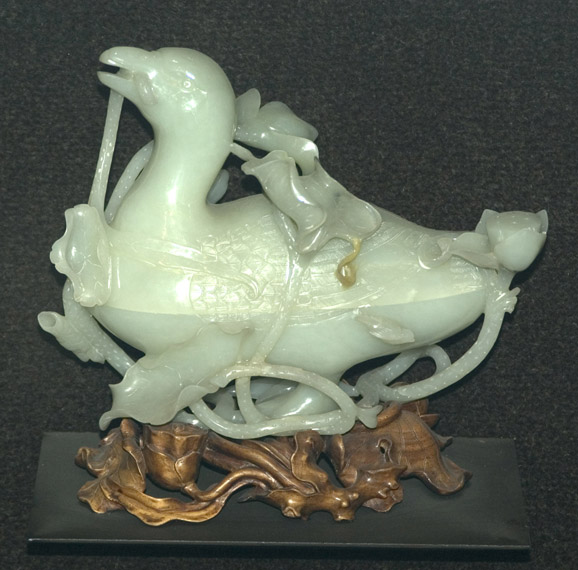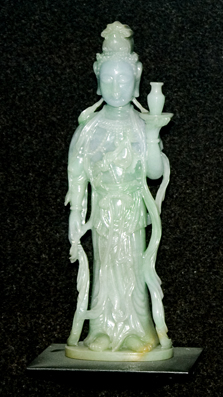
The Chinese have always had a high regard for jade. It is certainly more precious than gold in its finer quality.
Crystal system: Monoclinic
Chemical Formula/composition:JadeiteNaAl(Si2O6);
Nephrite
(a variety of actinolite) Ca2(Mg, Fe)5Si8O22(OH)2
Crystal habit: Fibrous
masses; often collected from alluvial deposits
Hardness: 6.5
- 7; 6 - 6.5
Specific gravity: Jadeite:
3.3 - 3.5; Nephrite: 2.90 - 3.02
Luster: greasy
and sometime chatoyancy
Toughness: extremely
tough (high tenacity)
Cleavage: Not
apparent due to fibrous nature
Color: almost any color: orange,
yellow, pink, green, blue, lavender, black, white
Localities: Jadeite--
Myanmar ( formerly Burma) is the source of imperial jadeite, Monterey
Co., California; Guatemala (source of Mesoamerican Jadeite); Nephrite--
Canada, Alaska, New Zealand, Poland, Turkestan, and many other places.
Common simulants: soapstone,
onyx, and other materials are carved and may be called jade
Synthetics: none
Sadly, jade is a very imprecise term. Really it describes two different minerals, jadeite and nephrite. Both minerals have similar properties and form a dense fibrous rock. Yes, rock. Both types of jade are made of matted fibers of minerals that give jade a very high tenacity. Jade tools such as axes were used by Neolithic peoples of Europe, the Americas, and the Orient. The fibrous habit of jade means that it carves very well.

The Chinese have always had a high regard for jade. It is certainly
more precious than gold in its finer quality.
Precious jadeite, the more valuable of the two minerals, can command
prices that are as high as diamonds in its finer colors. Some Burmese
jadeite (Myanmar is the modern name for Burma) has a color and translucency
that reminds people of emerald. Fine colored jadeite, aka imperial
jadeite, is rarely carved anymore, but is made into cabochons for rings,
earrings, and pendants. Less valuable pieces are carved and fashioned
into decorative pieces, amulets, bracelets, rings, etc.

Nephrite is less valuable, but still very desirable for carving.
In ancient China it was the only known jade until jadeite deposits were
discovered in the 1700s in Burma. The Chinese always imported jade;
no important deposits were found in China until China absorbed areas bordering
it after the cultural revolution. Hence all truly ancient jade from
China is nephrite until the mid to late 1700s when jadeite was first procured
form Burma.